Felis Catus, the domestic cat that plays a pivotal role in our lives, is born and lives in a broad range of circumstances, from pampered house cat to outdoor feral cats. Because cats in different environments all look so similar, it is easy to imagine that a feral cat is, or wants to be, a creature much like the cat curled up on your sofa. In truth, feral cats are very different from the cats we easily share our homes with. Feral cats are unsocialized to humans.
Alley Cat Allies knows of committed caregivers who invest all available resources to provide indoor homes for the feral cats they manage in an attempt to tame them. It is, unfortunately, a time-consuming project with a very low rate of success. And even if a feral cat does “tame up,” he bonds only to the caregiver who brought him inalmost never to other humans or homes.
Alley Cat Allies does not encourage attempts to adopt adult feral cats. Read on to understand why and learn better ways to help feral cats.
Feral Cats Belong Outside
Why do humans feel compelled to provide indoor homes for feral cats, and why do the cats resist these good intentions? It is inherent in human nature to want to nurture and care for those we perceive to be in needto make them warmer, cozier, safer, and therefore happier. It is an admirable trait, but not always appropriate. The impulse to bring every feral cat “in from the cold” reflects our human needs, but it isn’t best for the cat or what the cat wants. Feral cats have lived their entire lives without direct human contact other than, perhaps, daily feeding and monitoring by a caregiver. Their arsenal of survival instincts includes wariness of humans in general and a sharp fear of confinement.
Even if you have fed a feral cat for a long time and he has come to trust you in an outdoor setting, he will lose that trust when confined and it may never be regained. Being forced into a house or other structure can be the most frightening experience possible for a feral cat. He may appear to acclimate, or at least may stop hissing and cringing, but he is never at ease and never stops looking for a way to escape. The stress of such confinement can harm the cat’s physical and mental health.
A feral cat’s home is where he has spent his entire life. Feral cats form strong bonds with one another and with their home territory, bonds that define their daily existence. It may be difficult to accept that, despite the strong human-animal bond you have formed with the cats, their animal-animal bonds and animal-territory bonds are stronger and more relevant to their well-being. They are content outdoors.
Another factor that inspires some people to want to tame the feral cats they care for is the misperception that feral cats live short, miserable lives.
The truth is that the well-being of feral cats is most compromised by behaviors associated with mating and giving birth to endless litters of kittens. Spaying and neutering significantly changes the picture. Male cats no longer fight and roam. Female cats no longer bear kittens. Feral cats frequently live 10 years and longer and have the same rates of disease as pet cats.
Nurturing through Fostering and Trap-Neuter-Return
How can a caregiver’s desire to nurture best be expressed? By carrying out Trap-Neuter-Return. A major and critically important component of Trap-Neuter-Return is socializing and adopting kittens and adult stray cats. When given individual love and attention, young feral kittens can usually be fully socialized to become household cats. Neonatal kittens separated from their mothers require bottle-feeding to survive. Adult strayscats who for one reason or another lost their homescan often be re-socialized and re-homed. Fostering kittens and strays is a valuable contribution to the process. It is also a better use of resources.
The Greatest Possible Good for the Greatest Number of Cats
The goals of the feral cat movement are:
- To change the way feral cats are routinely treated in this country;
- To recognize their right to live; and
- To improve the quality of their lives through spay and neuter.
In other words: to save and improve the lives of as many feral cats as we can.
Managing populations through adoption is not possible. Even if adoption were the most desirable course, resources do not exist to socialize and adopt the tens of millions of feral cats in this country.
And yet, with the time and energy that goes into trying to socialize one adult feral cat, dozens of cats could be spayed or neutered and dozens of friendly stray cats and kittens could be placed for adoption, thereby having a real impact on saving cats and improving their lives.
It is time to frankly examine our reasons for working on behalf of feral cats. Even caregivers who are involved only with the cats they feed on a daily basis are, nevertheless, part of the big picture, of the dynamic movement to help cats that began some 20 years ago in the United States.
If the goal truly is to bring the greatest good to the greatest number of cats, then the best way to reach that goal is through Trap-Neuter-Return.


